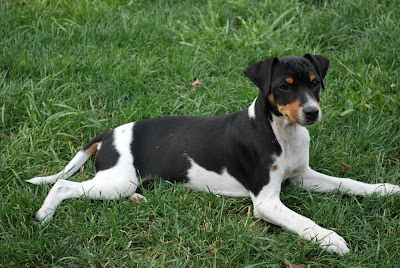First breed, and the one closest to my heart (since it is from the same country as me) is:
Danish Swedish Farmdog/Dansk Svensk gårdshund
 |
| Picture borrowed from http://violasjasmin.blogspot.com/. |
This dog was common on farms in southern Sweden and Denmark and was kept mostly for keeping the rats away, to guard the farm and as a companion dog. Today most DSFs are just active companion dogs that do well in different dog sports, such as agility and obedience. The DFS was recognized as a breed in Sweden and Denmark in 1987, and internationally by the international dog organization FCI in 2008.
Appearance: The FCI standard says that a DSF should be 30–39 cm of height with a compact body. The relation between withers height and body length should be 9 to 10. The head is rather small and triangular with a well emphasized stop. The coat is hard, short and smooth in texture, with white as a dominating color, with one or several patches of different color combination. The tail could be long, half bobtail or bobtail.
Then we have the spanish version:
Ratonero Bodeguero Andaluz
| Picture from wikipedia |
The name means "the Andalusian wine cellar keeper's rat hunting dog", and as the name clearly tells us this is, like the DSF, a dog that is kept mainly to keep the rats away. The RBA was recognized as a breed by Spanish authorities in 2000, it has yet to be internationally recognized as a breed.
Appearance:
The Ratonero Bodeguero Andaluz is of medium size, measuring between 13.75–16.9 inches (34.9–43 cm) at the withers. The breed is an agile dog with a lean and athletic build; the head is triangular with a semi-flat skull. The eyes are very dark and the Ratonero has a long muzzle, and high set ears that bend over at the tip. They may also be born with a natural bobtail. The coat is short and dense, which is typically white. Its facial markings are a mixture of brown, white and black markings (known as tricolor).
The last breed which is very similar to the other two is from Brazil and is called
Brazilian Terrier/Terrier Brasileiro/Fox Paulistinha
 |
| Picture borrowed from http://brazilianterriers.com |
This little terrier, like the other breeds previously mentioned, is a rat hunting dog. From what I've been able to find (with my lacking knowledge of the Portuguese language) this breed is not recognized by either national or international authorities, but is referred to as one of only two national breeds of Brazil, so I might be wrong. It is however not recognized by the international dog organization, FCI.
Appearance: This terrier stands between 14-16 in (35.5-40.5 cm) at the withers. Its appearance is typical of dogs descended from fox terrier types: the short coat is tri-colour (white with markings in two other colours; permissible colours are black, tan, brown and blue). The skull is flat and wedge-shaped, with folded ears.
Breeds and health - Sister breed mating?
All three breeds are the approximately the same size, with a small difference in muzzle length and ear position. They all have similar history and same "job". Their temperament is similar. For me, it is a mystery why these breeds can't be considered one and the same, and by doing so reducing the effects and problems of inbreeding that the dog breeds of today are struggling with to a greater or lesser extent. All of these three breeds are generally healthy, but I would very much like to keep it that way. So instead of having the risk of ending up like the Boxers or Cavalier King Charles Spaniels, where different hereditary diseases are more of a rule than an exception, I think it is time to lessen the rules of "pure-breeding" so that breeds that are similar can be interbred. The puppies of such mixed matings will contribute with valuable genetic diversity to both breeds. To decide which breed the puppies should be included in, maybe one could for example evaluate the puppies after a year and then decide what breed the individual puppies should be registered as. I don't know... but I know that something has to be done in order to save the future dogs from lifelong agony, pain and stress.

You should also consider the Tenterfield Terrier from Australia, Rat Terrier from the US and Japanese Terrier as well since all have the same historical background, and similar phenotype.
ReplyDeleteThe dogs of this species are very tricky. Those who look at their appearance can be understood that they are very tricky.Such dogs are seen in Sweden.Thank you for your post… http://onedaytop.com/remove-pet-hairs/
ReplyDelete